Hummingbird
Archilochus colubris
Ruby Throated Hummingbird
————————————————————————————
Nature Photography by Ike Austin – Michigan
Photography that is Therapy for the Soul
Michigan Birds
Archilochus colubris
Michigan Hummingbird is the teeny weeny, itsy bitsy, tinniest, miniaturist, pee wee of all birds. Yes, the Hummingbird is itty-bitty, minature tinny, littlest, smallish, pocket-sized, mico, mini of a birdie.
Small But F-a-s-t! I Do Mean Fast! –
The Hummingbird is fast. Hypersonic in fact. It’s a little speedball, can move like mad. It’s agile, brisk, quick and swift. It is to fast to see, just a blur if right in front of me. It’s a jiffy dot with wings, moving in a blink from place to place in nothing flat. Hummingbirds move at breakneck speed, are fast as lightening, dashing, flashing, quick as crazy. See this photo… Rudy Throated Hummingbird
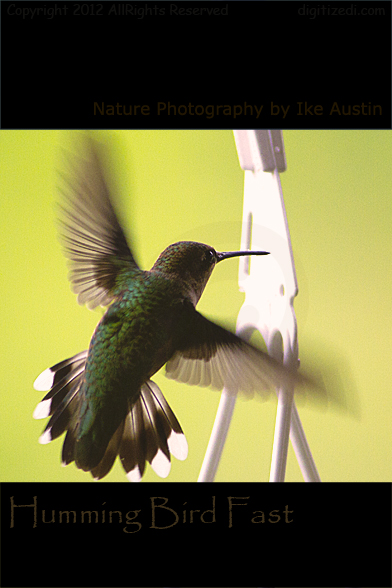
Humminbird – Full Spread
The Hummer can zoom to and fro smooth as quick silver, faster than Sammy Davis, quiet as a mouse. It will zip, zip, zip from pedal to pedal, seeking what it may find. Nectar here, nectar there, from bloom to bloom; darting in and out.
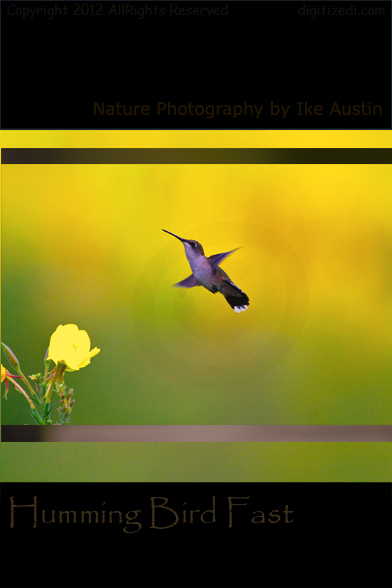
Hummingbird
The Hummingbird is faster than Gun-Smoke, quicker than Sun-Dance Kid. I draw my guns, point it to the tip of your nose, slap your face, and re-holster all before the word… “Draw.” Or, should I say, all before the letter “D” is pronounced.
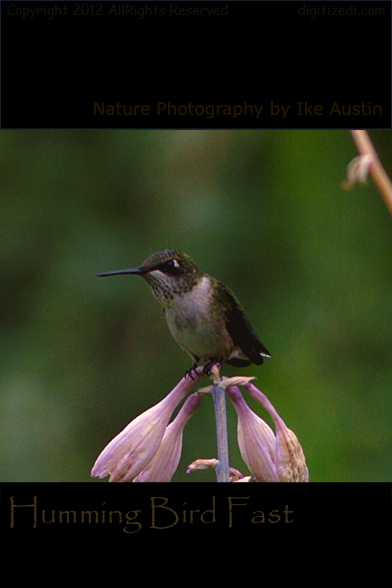
Hummingbird Pictures – Resting on Hosta
Yes, I’m fast, faster than a speeding bullet, an 8 armed ocotups, a rat-trap, a blink, a wink, much quicker than a finger snap. I’m faster than Mohammad Ali, quicker than his fastest jab. He go “jab-jab”, I go… “buzz-saw” (1000 jabs to his one). Blistering quick, instantaneous fast, I’m double-quick, sudden-swift, the winged wonder of birds.
I might be small, but I’m faster than them all, that’s why “I am Legend”, and they call me “The Hummer.”
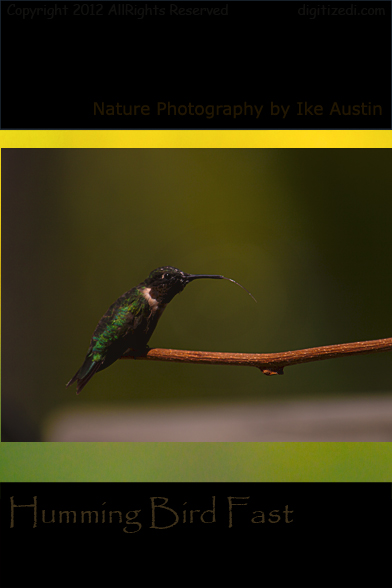
Ruby throated Hummingbird – Nectar Extractor.
All About the Red Throated Hummingbird
Nature Photography – Michigan Bird Identification
Photo Taken: Michigan Wetland
Family: Trochilidae
Name: Ruby-Throated Hummingbird
Archilochus colubris
Appearance: The Michigan Ruby Throated Hummingbird is a 4 inche bird with, green plumage, white under body, and red throat..
Adult: Color is metallic green, female is green without the red throat.
Flight Characteristics:
Quick blurry fast beats, smooth continual flaps when in flight. The Red Throated Hummingbird is a fast and swift flier, can abruptly change directions on a dime.
Habitat: The Hummer prefers of course small inland water reservoirs, lakes, ponds and wetlands, parks, and back yards.
Nesting: Hummingbirds will construct nest made of grasses and line with down. Nests are minarature deep pocked cups.
Incubates 2 whitish eggs for appx 13-16 days.
Mating Habits: The Common Mallards mate for extended periods.
Feeding: Uses its long beak and tongue to draw nectar from flowers.
Call: Sharp chip.
Migration: Travels a remarkable 500 miles to South America in late fall October.
Bird Conservation in Michigan
Michigan Bird Conservation Initiative
Department of Natural Resources
Check the Cornell University Department of Natural Resources for Attracting Hummingbirds to your yard., Learn More… Attracting Hummingbirds
—————————————————————————————————
Nature Photography by Ike Austin – Michigan
Photography that is Therapy for the Soul
Michigan Birds
Nature Photography by Ike Austin – Michigan
Photography that is Therapy for the Soul
Michigan Birds
—————————————————————————————————————————————
Birding Associations and Organizations
This Weeks Honorable Mention:
Michigan Audubon Society
Purpose: Michigan Audubon connects birds and people for the benefit of both through conservation, education, and research efforts in the state of Michigan. Read More Here… Michigan Audubon ORG
Nature Photography – by Ike Austin
Nature Photography that is Therapy for the Soul
The Most Beautiful Stained Glass Hand Crafted Sculptured Monarch?
In one of my many excursions into the hidden forest of Jimme’ I would often find myself taking a turn and walking down an unplanned path. The path I chose this day was narrow, with tall grasses and loose foliage hanging along both sides of the ever narrowing trail.
It was a dull lit day with a sustained overcast due to endless clouds that covered the sky. As I continued further my attention was drawn just up the trail to some movement on my left. Slowly moving closer, I noticed a small repetitious fluttering motion, I could see that it was a Monarch Butterfly (the trained eye would identify this butterfly as a Viceroy-distinguished by the black line across the bottom wings.)
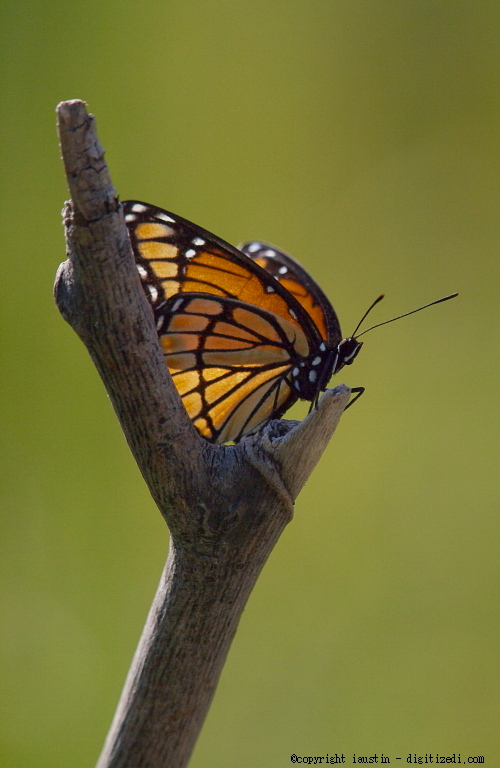
Monarch Butterfly Finger Pointing Toward the Sky
I immediately began snapping as many photos as I could because it was rare for a Monarch/Viceroy to allow me to get so close and not be spooked by my presents.
Occasional sun-rays would penetrate the clouded overcast and provide periods of welcomed sunlight.
After returning home and starting to review the photos, I did not notice anything striking about the butterfly. However, when my wife looked at the photographs she got rather excited. She asked… “doesn’t this branch look like a hand and the butterfly are sitting on the tip of the index finger?”
On my second look at all the photos, yes indeed, the branch does look like a hand and it does look like the Monarch was perched on the tip of a finger pointing skyward.
The whole scene, with the sunlight serving to back-light the butterfly wings, looked more like a handcrafted, stained glass artist sculpture.
A Most Beautiful Monarch Butterfly Scene
Other Nations, Other Kingdoms – Geese and Herons
Messages From Nature | In the Silence
A sunny, but rather chilly morning with a slight breeze… I stood in the hidden forest of Jimmie’ on a small knoll looking out pass several large trees. My sight fixated on a large gaggle of geese off in the distance, numbering in the hundreds, some on land, others waddling about on the seashore.
My attentions drifted further down the shoreline, where I noticed an equally large gathering flock of herons. I observed both colonies of birds the geese and herons, for several moments as each group interacted among themselves. Both groups of birds with vary different characteristics are sharing and occupying the same space, time, and resources without laying claim to territory.
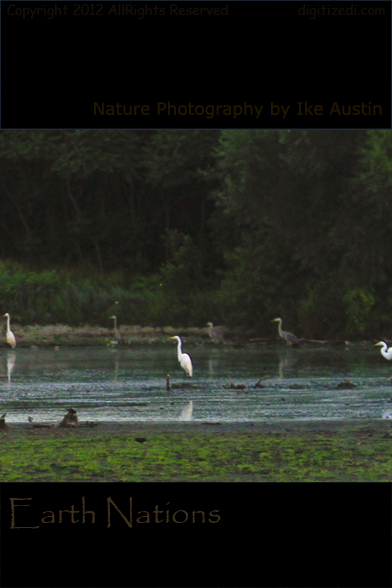
diversity earth nations 1
Then as a common occasion, the voice of silence speaks directly to my mind. Such times the River’s Sky takes such opportunity to dialog on undiluted truths… “these are kingdoms, different kingdoms side-by-side sharing the same water, yet they seek not to exterminate each other.”
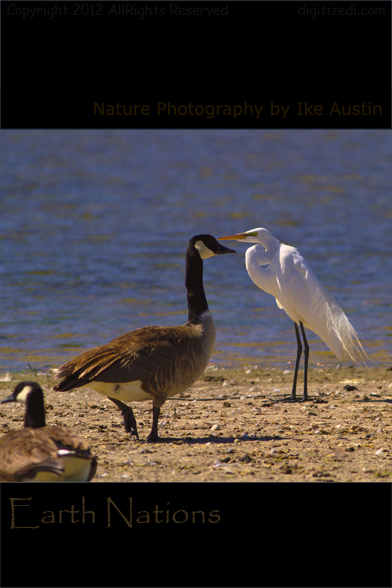
diversity earth nations 2
I understood this statement to mean these birds are representations of kingdoms that are not of earth, but, the kingdoms are of another place much different from the volatile kingdoms of earth. In my many descent-level travels, I witnessed such a diverse kingdom once. Its empire stretched beyond its solar system and the inhabitants occupied every planet, asteroid, and moon. They were benevolent and conciliatory in their actions; the most powerful toward the lesser; the musk-ox thunderously stomped along the outer edge of galactic devices in its movement, kept a keen eye on the lowly prairie dog to be unharmed.
Here, kingdoms of earth are quite the opposite; forged by size, shape, and color of men. All religions, all kingdoms of earth and their proposed treaties for peace represent covert continual deceit, declaration of silent murder genocide, a perpetual existence that seeks to exterminate all other kingdoms fueled by religion and color of men? In testament to this statement is countless glorious ruins, ancient & modern, from the bottom of the sea, and found on every continent. Here in plain site, across eons of time, lay all the evidence… that only cannibalistic kingdoms inhabit earth, all the plundered ruins of past and pillage of current nations (the stronger pillaging the weak) support this claim.
Stolen Titles – All earth kingdoms proclaim the title of “Nation;” but does the historic blood signature bare this out? Or, following a long trail of earth’s blood signature we can conclude… earth is not the place as some claim it to be. This place called earth, bares a stolen title in resemblance only of another far away place also known as… “The Earth.” In this far away place, the geese co-exist with the herons.
All earths are not equal.
In silence I hear deeper truth
— ThirdSon and the River’s Sky
Nature Photography – by Ike Austin
Nature Photography that is Therapy for the Soul
| ThirdSon and the River’s Sky | |
|
|
|
Bald Eagle – Soaring High
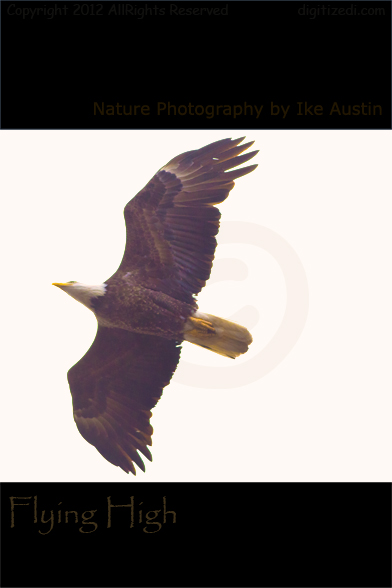
Michigan Bald Eagle – Flying High
Caught this Eagle flying high, soaring majestically overhead, cruising through a light early morning fog following the lakeshore outline. See more photos here… Michigan Bald Eagles.
The Hawk, a Symbol of the Highest
Suddenly, a young juvenile Red-tail hawk raises its wings, high above its head, creating a most spectacular and grandeur posture. The majestic bird is fixated on something far off into the distance, perhaps on some unsuspecting prey. With a laser like focused stare, a natural small glare of sunlight adorned the top of the birds pupil, with a rightfully placed star in its eye …the bird rose.
For this picturesque moment, the Red-tailed Hawk is a magnificent statue of nobility.
Nature Photography, this Hawk is a portrait of envious kings of the earth, and to those who watch from hidden dominions; with wings that would capture the attention of Gods, lesser gods, and the admiration of men. He would be drawn, painted, sculptured, and claimed as the royal symbol of many nations. Even among those who proclaim themselves to be of the sons of the living god, they too have claimed the majesty of the Red-tail as a symbol of their own.
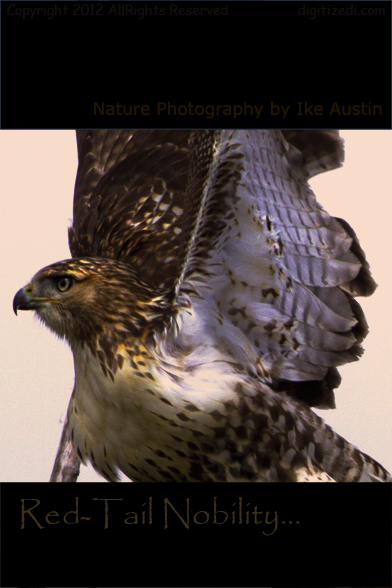
The Red-tailed Hawk is legendary among Native Americans. These people were of the few civilizations of earth who saw the true purpose of nature; as a manifestation, a representation, a visual form of communication from a higher form of life reaching out toward all who have the gift to behold. And those rare individuals that remain, those few who still interpret the esoteric symbolism of unpolluted nature, they are in constant visual, silent communion. When such persons visit nature they stand in respect, because they are aware they are witnessing a flow of living words being spoke by… the creator.
̶̶̶—ThirdSon and the River’s Sky
A Tribute:
Nature Photography Red-tailed Hawk
The earth is much mis-understood, it is not what you have been told.
|
Lessons Learned – Dialogues in the Forest of Jimme’ Nature Speaks – Nature Photography, Therapy for the Soul – Everyone can Hear Nature Speaks – Through Birds – Therapy for the Soul The Opening – Message in the Rain Michigan Bird – Mallard Duck – Sun and Darkness Dialogue Michigan Bird – SandHill Crane Ancient Feet Dialogue Birds of Michigan – Great Horned Owl Dialogue Birds of Michigan – Great White Egret Dialogue Birds of Michigan – Green Heron Dialogue – One Strange Sunset in Jimmie’ |
Other Links to View More Details and Photos
Giant Talons of a Redtail – Wild Life Pictures: MONSTER GORILLA TALONS
Nature – Photography See Upclose, Full Spread Fanned Red Tail Image
National Geographic excellent line drawings and red-tailed good detailed description.
Nature Photography by Ike Austin – Birds of Michigan Series
Photography that is Therapy for the Soul
Haliaeetus leucocephalus
Bald Eagle – The Power
One solitary morning I was far off the trail deep into a secluded wetland. On a previous visit to this remote habitat I discovered a pair of Michigan Bald Eagles nesting on the far side of the landscape. Casually walking toward their location with my head down, in deep thought, with my camera gear shoulder strapped hanging at my side (trigger finger always at the ready), I was suddenly startled! A huge shadow passed over me, engulfing my entire area, then another shadow just as large as the first glided over the ground. I experienced a strange sensation, for the first time I understood how a prey might feel, to know what it is like to become prey, to fear the shadow, to understand what a typical day might be like for the many animals that are lower down the food chain.
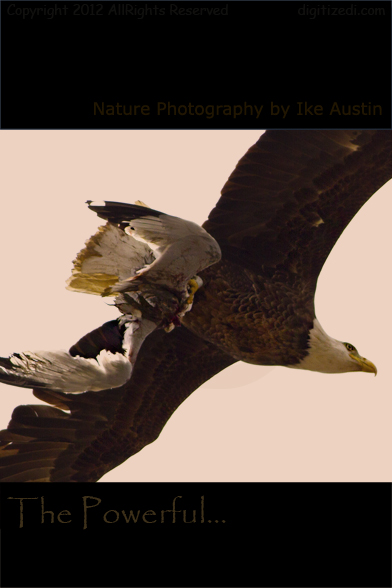
Looking up, I saw two large Bald Eagles directly overhead. I whipped my camera off my side like a cowboy in an old western, pointed skyward and started firing off a rapid series of camera shots that would have made the likes of old gunslingers proud. The first Eagle had already traveled a good distance, but I was fortunate enough to capture some good shots of the second Michigan Bald Eagle. This Bald Eagle was the one to focus on because it was carrying the remnants of a carcass from another bird that to me looked like the remains of a seagull.
Staring upward I continued to watch the pair of eagles glide further toward their nest with the bounty hanging, held tight in the grasp of those powerful automatic knives of the Bald Eagle’s called talons.
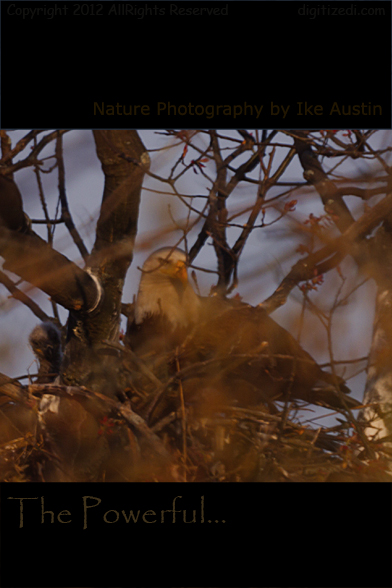
Bald Eagle Nest Michigan
Eye of the Eagle
I began to wonder about the confrontation between the eagle and that unfortunate seagull. The eagle is giant in comparison to the gull, and outfitted with the ultimate destructive tools for engaging in war; powerful razor sharp talons combined with a double sided razor sharp beak. Not to mention flight agility that rival even smaller birds.
I was close enough to look into the eye of the eagle, it seems to become aware of my presents below and I could began to sense its mind. The eagle had no fear of my presents… and I for that brief moment of contact sensed the words of omnipotence, and from the mind of the eagle it asked… what real chance does a gull have against one so awesome, fearless, and so equipped?
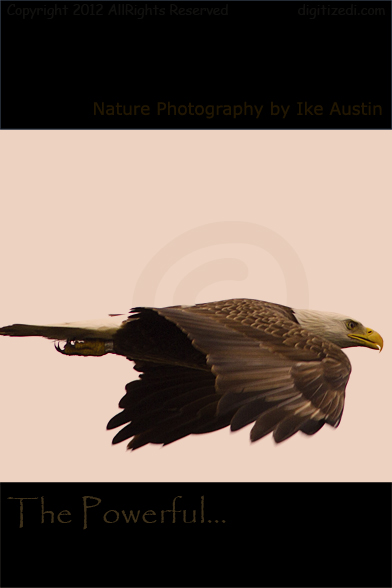
Dialog With Nature – The Twelfth Dialog
I understood that such thought provoking questions from the River’s Sky were an open invitation for a period of serious expansion dialogue, an exchange with nature, where nature itself would reveal unpolluted truth, a direct infusion to my mind. As always, I was eager to engage the company of the many.
From this dialog, I came to learn about the true esoteric symbolism of the eagle, the important meaning of the Bald Eagle and the Seagull as it relates to the smallest and the greatest of life’s scenarios; such as humanity and the other beings who’s domain exists far above and beyond ours, overhead, high among the stars. Over long periods of time with this mystical sky, I would slowly come to know of many other kinds of men; their true powers, numbers, purpose.
Indeed few Seagulls have witnessed an up close sight of a Great Bald Eagle, but those fortunate to have only observed a great bald eagle at a safe distance, would no doubt be spiritually overwhelmed by the sight of one.

Nature Photography – Bald Eagle, The Powerful
In my earlier descents, I once saw the powerful. I saw one who sat in total obscurity, he desired no dialogue, nor sought tribute. He was meticulously scanning entire galaxies of existence. He detected my presents and was not alarmed. He did not seek my attention and I knew to remain un-disturbing to him. But, from his seat, he comprehends the going and comings of trillions, the rise and fall of galaxies. The fate of the largest stars were in his memory along with millions of galaxies as reflection in his mind.
This person, I saw that long time ago, he was and still is an unknown power to many. Now, some 50 years later, during my dialog with the many, the River’s Sky reminded me of this powerful obscure person… I am reminded of the Eagle and the Gull.
In silence I hear greater truth.
—ThirdSon and the River’s Sky
View other Michigan Birds Here… Michigan Birds.
About the Bald Eagle
Nature Photography – Michigan Bird Identification
Photo Taken: Lake Erie Metro Park
Group: Hawks and Eagles
Name: Bald Eagle
Haliaeetus leucocephalus
Appearance:
The Bald Eagle can have up to an 8 foot wing span. The mature(4-5 year old) bald eagle is adorned the infamous white crowned head. Brownish-black plumage front and back.
Adult:
White crown head. Color is majority dark brown and black, female is same color no crown.
Flight Characteristics:
Slow wing flaps, several flaps then pause and soars into a glide once into flight. The Northern Bald Eagle is an aggressive and combative flier.
Habitat: The Michigan Bald Eagle prefers parks, lakes and wetland areas.
Nesting: Eagles will construct rather large nests. Made of large sticks and can measure about 15 – 20 feet across.
Nest Location:
Nests are located 40-100 feet above the ground at the top of tree structures.
Incubation:
Incubates 1-3 (white perfectly shaped round eggs for appx 30 days (1 month.)
Mating Habits: The Bald Eagle mates for life.
Feeding: Fish and small animals.
Call:
Loud and cankerous.
Regular Season: Winter at Lake Erie Metro Park
—————————————————
This Weeks Honorable Mention
Associations that we feel provide real value to the birding community.
Caring for American Eagles Website
Purpose: The American Eagle Foundation is dedicated to protect the majestic Bald Eagle.
Membership Required: N, $Donation Y.
Informative Website Information: Y
Year Long Events: Y
Active Birder Blog(s): Y
Dialogue With Nature Informative Rating: 8
Merchandise for Sale: Y
Michigan Eagle Facts
Bald Eagle: Research and statistics, abundance and population, breeding, distribution etc. Bald Eagle Details and Facts
Michigan Department of Natural Resources (DNR) Bald Eagles and Michigan
—————————————————————————————————
Nature Photography by Ike Austin – Michigan
Photography that is Therapy for the Soul
Michigan Birds
Nature Photography by Ike Austin – Michigan
Photography that is Therapy for the Soul
Michigan Birds
One Bright Sunny Winter Morning in a Michigan Wetland – The Fat Wobbly Waddler Arrives
Anus Platyrhynchos
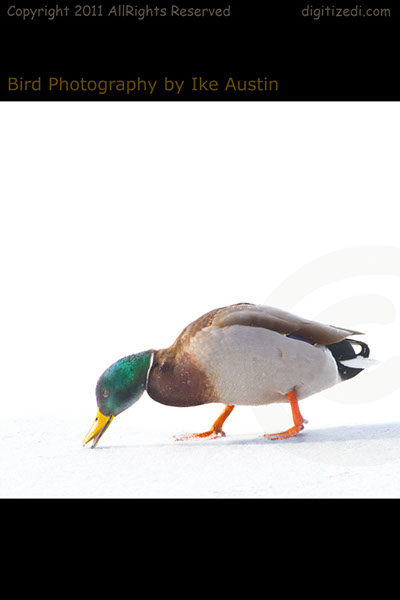
Mallard Duck Winter Walk
What’s the old saying… “if it walks like a duck, waddles like a duck, and quack like a duck, it’s a duck!” Off in the distance, slowly heading in my direction, I saw a fat, waddling what looked like an old, short, midget butterball of a little creature. But, it wasn’t a raccoon, it wasn’t a plump ground hog, it was in fat healthy looking duck. This Michigan Mallard Duck was multi-color; starting with an orange beak, followed by a metallic green head, brown neck, brown on top of its back(mantles), lower underbelly a grayish color of white, ending with orange feet with a black and white tail(coverts). The duck’s metallic green head is reminiscent of the same rich green metallic color of found on beetles. The vibrant tangerine orange of the duck’s feet is unsurpassed by man made color.
The Common Mallard is a summer and winter Michigan birds. Mallards are one of a photographer favorite. It is most recognized by its bright vivid green metallic plumage on it’s head.
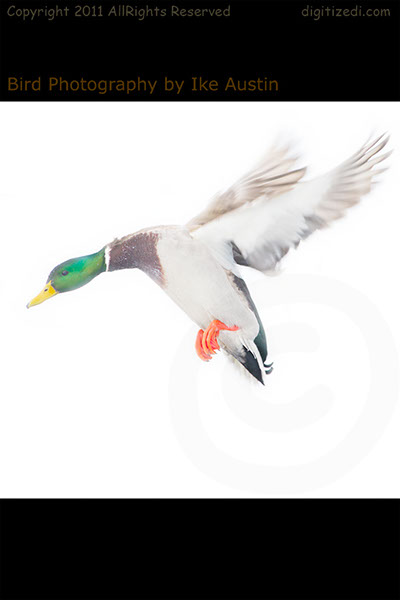
Mallard Duck Touch Down
Michigan Mallard
One snow covered morning, just as I entered one of Michigan’s favorite birding wetlands, I spotted a Mallard Duck making his descent onto a frozen lake covered with powder white snow. The sun was shinning bright and the surroundings bright white. I like to capture Mallards in action. Their wings outspread with feet tucked in and necks outstretched. Even better if the action is captured with a background color of pure white. On this particular excursion, the ground and sky were all reflecting the bright white light. This brightness gave the duck a brilliant glare, a star of green light of a Mallard gliding in slowly grabbing my attention. It had just stopped snowing and the ground all around looked like it was sprayed with a velvet coating of white angle hair. The full scene or white gave the impression that I was in the center of a white winter wonder land. This beautiful Common Mallard bird was nature’s center of attention.
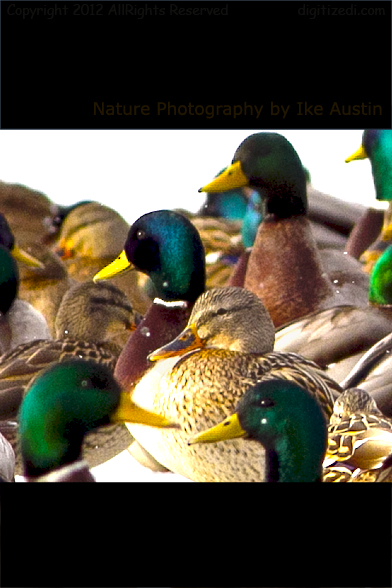
Dabble of Mallard Ducks
A Dabble of Common Mallards Male and Female
Mallards in Michigan
The sun was shinning, the scenery was true therapy for the soul. It has been said, “Man is never closer to God, than when he is close to Nature.” The Michigan Mallard’s landing here, took on the likeness of a story about heaven and the dove. I was ready to take the shot, my camera settings were set in high key to highlight the brightness.
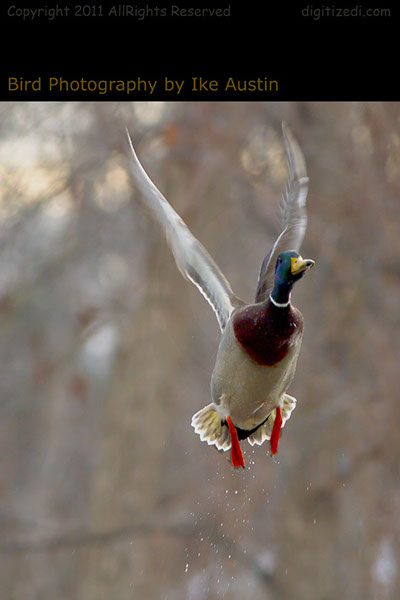
Mallard Duck Michigan
Mallard in Flight
The above shot taken of a Male Mallard Duck captured a duck rising from near vertical position. I did manage to capture a soft bokeh for the scenery background as droplets fell from the orange feet and the bird disappeared in seconds.
Mallard Fleet
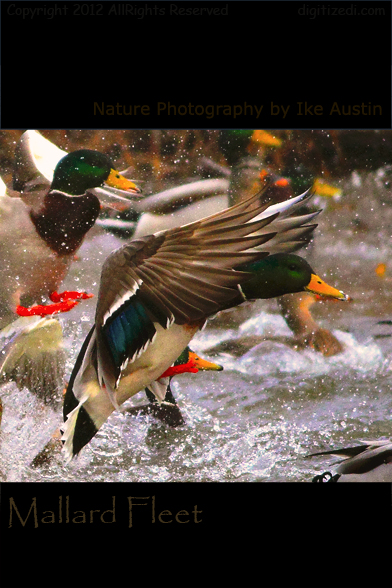
Mallard Duck
Lessons Learned From Birds of Nature
What looks common to the natural eye, looks extraordinary to the thirdeye. Encounter with a ThirdDuck in the Forest of Jimme. – ThirdSon and the River’s Sky.
The Michigan Mallard Duck is more alert and vigilant than I first thought. It sees a good distance capable of spotting danger at distances well over a hundred feet or so. The duck is not that timid. Once I was observed by a small Gaggle of Mallards I could tell had detected my presents however motionless I was at their arrival, after deciding I presented no danger, they settled in but kept a wiry eye toward my semi-camouflaged location. The Mallard can become accustom with human presents, I’ve seen them nesting in a Restaurants flower pot:). See additional Michigan Mallard Duck Photos Here… Mallard Duck Michigan Photo. View other Michigan Birds Here… Michigan Birds.
All About the Common Mallard Duck
Nature Photography – Michigan Bird Identification
Photo Taken: Michigan Wetland
Group: Waterfowl
Name: Common Mallard
Anus Platyrhynchos
Appearance:
The Michigan Common Mallard is a 20-30 inches bird with, green face, brown plumage orange feet.
Adult: Color is metallic green head, female is beige with dark brown specks.
Flight Characteristics:
Quick wing beats, several continual flaps when in flight. The Mallard Duck is a fast and swift flier, can abruptly change direction.
Habitat: The Michigan Mallard Duck prefers of course small inland water reservoirs, lakes, ponds and wetlands.
Nesting: Mallard will construct nest made of grasses and line with down. Nests are located fairly close to the ground.
Incubates 7-10 light green eggs for appx 126-30 days.
Mating Habits: The Common Mallards mate for extended periods.
Feeding: pond weeds and small insects.
Call: Series of infamous quack, quack, quack.
Michigan Department of Natural Resources
Check the Michigan Department of Natural Resources for Michigan Wetland Management, Learn More… WATERFOWL DNR Michigan
Check out this DNR resource… Identifying Ducks
—————————————————————————————————
Nature Photography by Ike Austin – Michigan
Photography that is Therapy for the Soul
Michigan Birds
Nature Photography by Ike Austin – Michigan
Photography that is Therapy for the Soul
Michigan Birds
——————————————————————————————————————————————————————————————————
This Weeks Honorable Mention:
National Wildlife Federation (NWF)
Purpose: The National Wildlife Federation is a voice for wildlife, dedicated to protecting wildlife and habitat and inspiring the future generation of conservationists. Read More Here… NWF Mallard Ducks and Details
Membership Required: Y, $30/yr. Includes award Winning Magazine publication AND a NWF field bag!!!
Informative Website Information: Y
Year Long Events: Y
Active Birder Blog(s): Y
Informative Rating: 10 (*****)
Nature Photography – by Ike Austin
Nature Photography that is Therapy for the Soul
Flicker the Bird – Speckled, Multi-Colored, Michigan Wetland – Brown, White, Red, Black and Tan
Colaptes auratus
The Michigan Flicker is a true multi-colored, patterned bird. The Norther Flicker has a dash of red on the back of the head, a swatch of black patch on it’s upper chest. Speckled front with black dots all over, with a splash of white on the end top of the tail. With sandy brown color near the upper crown, a strip of sportsman black just beneath the eyes.

Michigan Flicker – Gold Fingers
Michigan Flicker – But the most attractive color of this bird is the gold underside covering the entire mantle and tertials from the tip of it’s wingtip to the primary tip projection of it’s tail. Golden under tail coverts, gold colored greater coverts on the edge of the wings, median coverts where a golden slate colored shade of glitter, the greater primary coverts, the marginal, lesser, median, and greater coverts all different shades of gold, gold, gold.
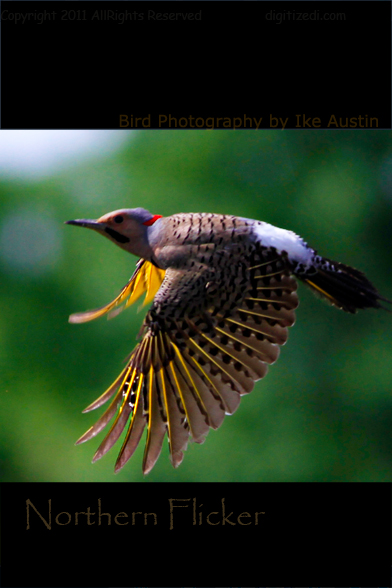
Michigan Flicker in Flight
The Northern Flicker is a summer Michigan wetland bird. This Flicker is mildly photographed bird. It is most recognized because of it’s speckled plumage and rather loud chitter chatty mating call early in the spring.
One hot early July summer afternoon I spotted a Northern Flicker darting across a wetland to eventually land on an extended tree branch. The day was clear and sun shinning bright; a great condition for capturing vivid elements of bird plumage color. During the early spring the Michigan Flicker will perform a series of loud mating calls followed by a rather rhythmical mating dance. This ritual will continue for several days with other male Flickers competing for the females attention. One one occasion I saw two Flickers locking talons as they spun around in a brief aerial dance. The Flicker will carve out a rather large hollow nest within an old dying tree. This is a very active bird that must remain ever vigilant, because the more numerous European Startling is in abundance and will try to steal the Flickers nest every chance it gets.
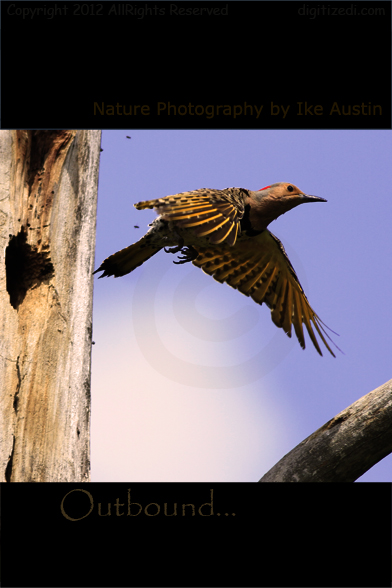
Michigan Flicker – Wetland
The Female Flicker, works in cooperation with the male. Both birds engage in house hold choirs and parenting the young. The birds take turns gathering food and returning to the nest. I was also fortunate to capture a shot of three young Flickers being feed by regurgutation. The three younglings still have about a couple more weeks before they are ready to fledge.
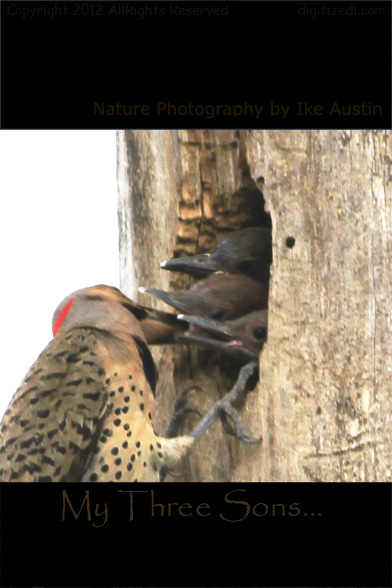
Michigan Flicker Younglings
Michigan Flicker Parenting
I was able to get a couple of good shots that clearly displayed what look like a rather stylish red t-bone located on the back of the Flicker’s head. I had to quickly decide and go-ahead and snap some close shots (something is better than nothing) before the bird fly off.
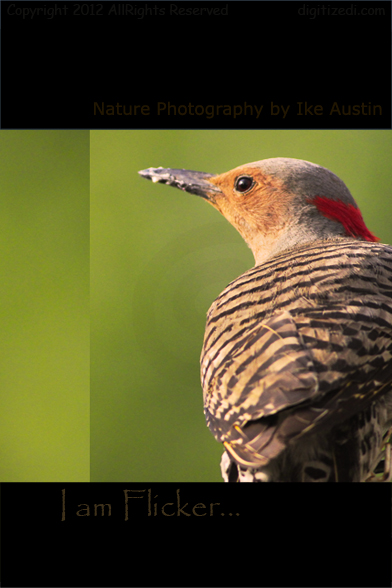
Michigan Flicker – Birds of Michigan – I am Flicker
The above shot of a Northern Michigan Flicker may not be the best photo, but I did manage to capture the bird in one of it’s many house cleaning flights.
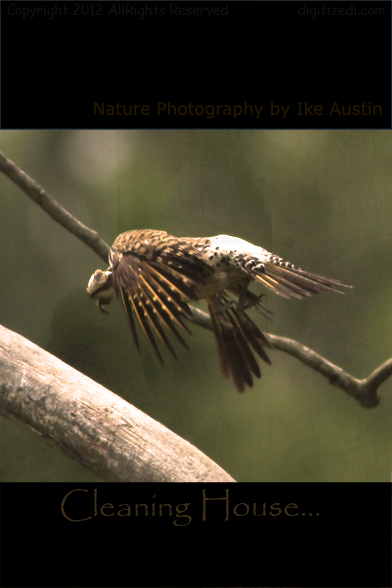
Northern Flicker – House Cleaning
Lessons Learned From Birds of Nature
The Michigan Flicker is a very vigilant bird, it has to be, the bird is under constant threat from other birds that are relentless in stealing the Flickers nest. During the feeding season, the Flicker is busy house cleaning, you can see the bird carrying numerous carefully wrapped waste sacks from the nest. What is most interesting, the Michigan Flicker will not just throw the waste out the nest to the ground. It is apparent that this birds has enough intelligence to is aware or possible threats; the bird seem to realize the presents of excrement might signal a hostile predator that a nest is occupying this particular tree. So, interestingly enough, this excrement is carried a considerable distance from the nesting location. View more photo here…
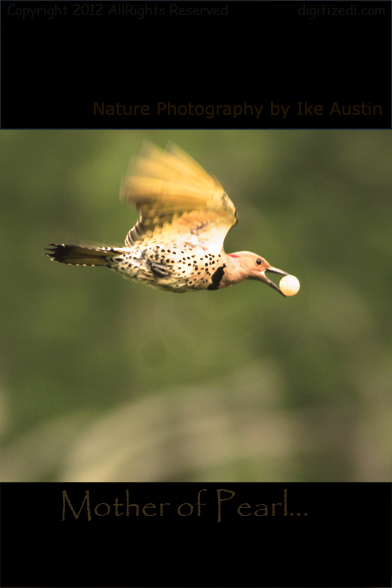
Northern Flicker – Carrying egg.
View other Michigan Birds Here… Michigan Birds.
About the Michigan Flicker
Nature Photography – Michigan Bird Identification
Photo Taken: Kensington Metro Park
Group: Wood Pecker
Name: Northern Flicker
Colaptes auratus
Appearance:
The Michigan Flicker is a 12-13 inch bird with, black speckled plumage front and back, the male is distinguished with a war paint black eye strip just below the pupil., or what might be considered the malar stripe area of the birds face.
Adult:
Color is majority beige and black, female is same color..
Flight Characteristics:
Jittery quick wing beats, several flaps then pause and a slip dip when in flight. The Northern Flicker is an average flier in terms of in flight speed.
Habitat: The Michigan Northern Flicker prefers parks, lakes and wetland areas.
Nesting: Flicker will construct or hew an open cavity nest inside old dead trees. A large cavity is created in preparation to contain several offspring.
Nest Location:
Nests are located 10-40 feet above the ground.
Incubates 5-8 (several white perfectly shaped round eggs for appx 12-14 days (2 weeks).
Mating Habits: The Michigan Flickers mates for extended periods.
Feeding: Seeds, insects (mainly ants), berries and some nuts.
Call:
Mating season; a s series of elongated rhythmical squeaks, which includes an bobbing up and down head motion.
Regular Season: A quick rapid series of chirps.
This Weeks Honorable Mention
Associations that we feel provide real value to the birding community.
Detroit Audobon Society Website
Purpose: To promote awareness and protection of the environment through education, research and advocacy Mission Statement and Code of Ethics… Read More Here… Detroit Audubon Society (link)
Membership Required: Y, $Donation/yr.
Informative Website Information: Y
Year Long Events: Y
Active Birder Blog(s): Y
Dialogue With Nature Informative Rating: 8
Michigan Bird Atlas
Michigan Flicker: Research and statistics, abundance and population. Read more here…
—————————————————————————————————
Nature Photography by Ike Austin – Michigan
Photography that is Therapy for the Soul
Michigan Birds
Nature Photography by Ike Austin – Michigan
Photography that is Therapy for the Soul
Michigan Birds
Michigan Sandhill Crane is King of the Noise!
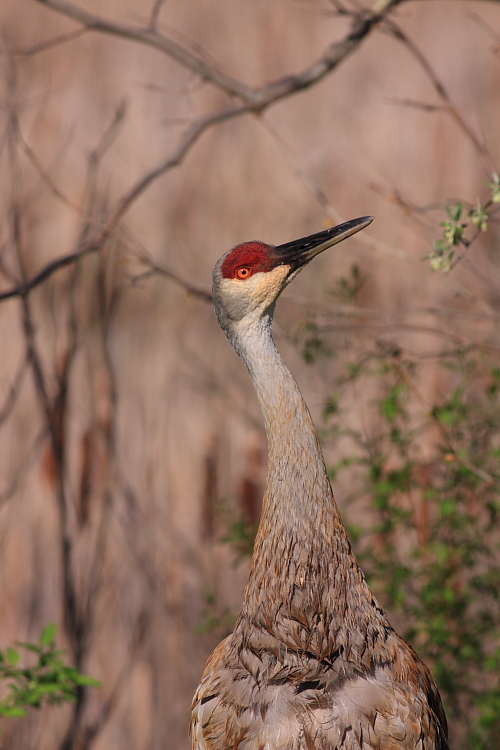
Sandhill Crane Michigan Bird by ike austin
No other bird of any size can bellow out a louder noisy echo than the Sandhill Crane. More notably, a pair of Sandhill Cranes. The loudest title among birds use to belong to the Canadian Geese. But in more recent years, a new claim to become nature’s head trumpeter has shifted to another of our feathered friends. Yes, a new king of the noise with at least five times the volume, that carries ten times the distance, and in unison, in perfect synchronization between a pair of cranes… the birds, are relatively new comers to the Michigan landscape. Learn more about the Michigan Sandhill Crane. You can listen to the calls of the cranes here… Calls of the Cranes
—————————————————————————————————
Nature Photography by Ike Austin – Michigan
Photography that is Therapy for the Soul
Michigan Birds
Nature Photography by Ike Austin – Michigan
Photography that is Therapy for the Soul
Michigan Birds
————————————————————————————————————————————————————————